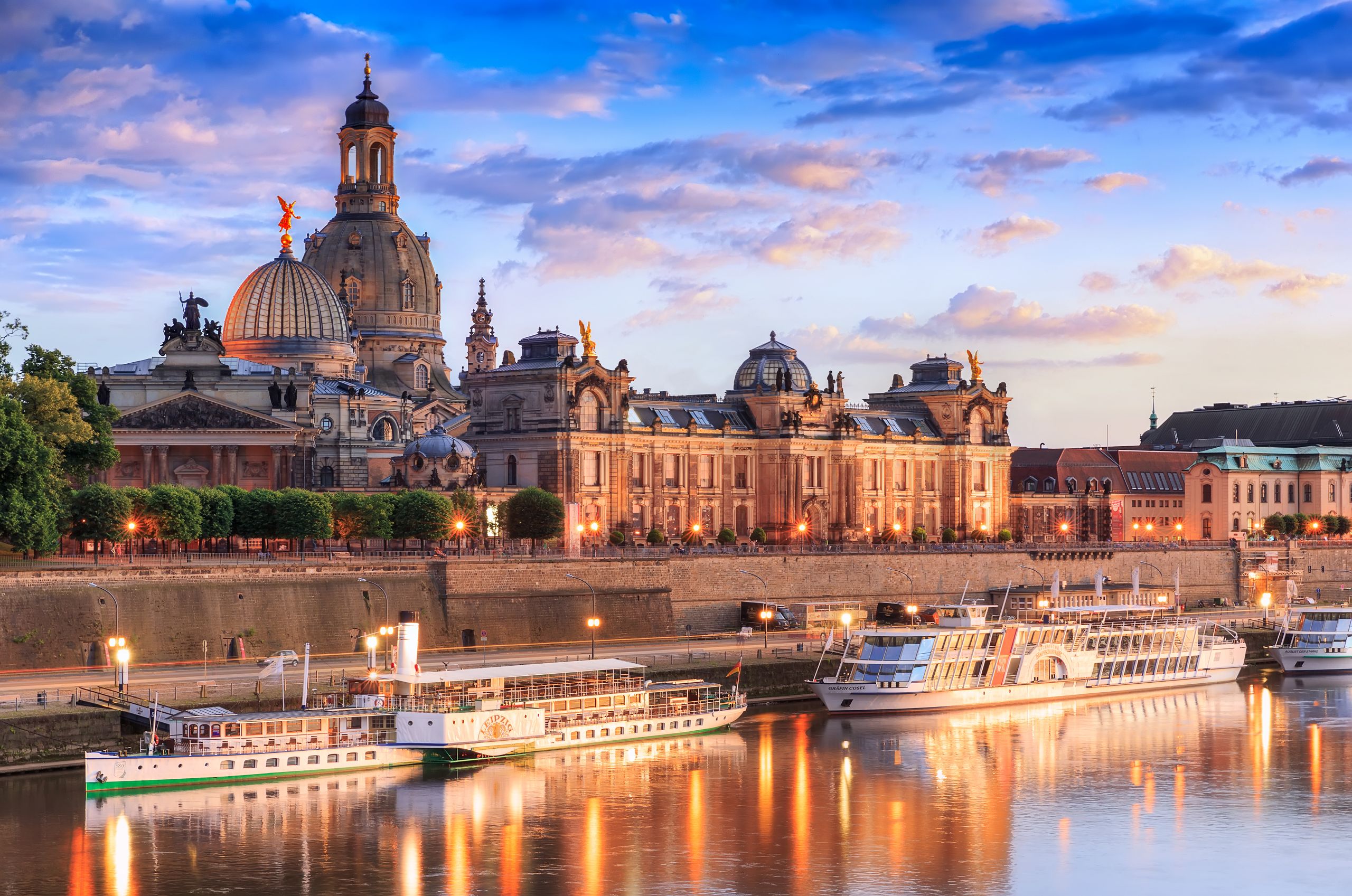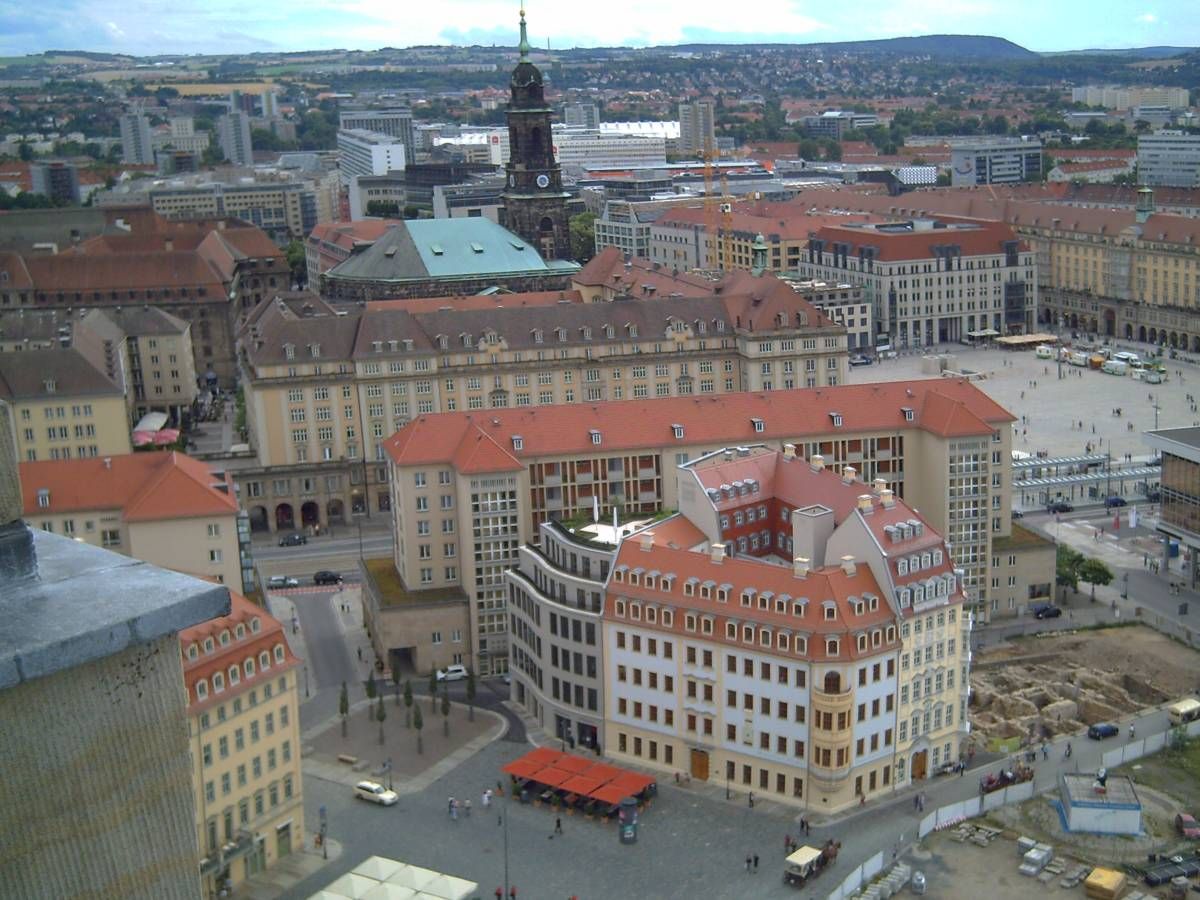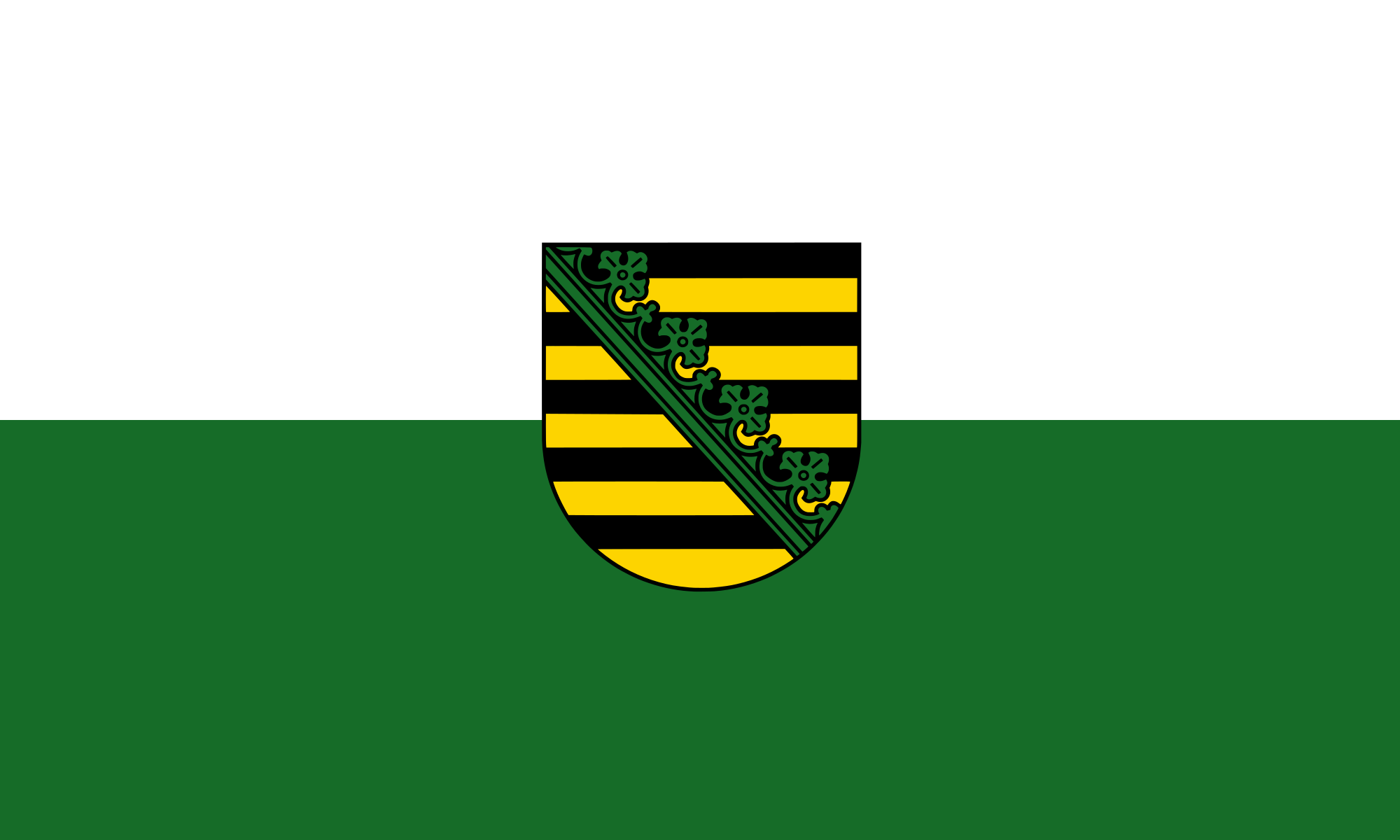

德累斯顿(德语:Dresden;捷克语:Drážďany;索布语:Drježdźany,意为河边森林的人们),是德国萨克森自由州的首府,德国东部重要的文化、政治和经济中心。它位于德国的东南方,易北河谷地,南面离捷克边界仅30公里,距捷克首都布拉格150公里,北面距离德国首都柏林200公里,离西北方萨克森州另一个大城市莱比锡100公里。
德累斯顿的城市人口超过56万(2016年),都会区人口共有125万,而德累斯顿所在的萨克森三角城市聚集区共有320万人,被列为德国主要大城市之一。 残留的考古学上的踪迹可以证明,后来成为城市区域的地区在石器时代已有人类定居。在可考的文字记录中,德累斯顿最早于1206年被提及,并被发展为选帝侯以及后来的皇家领地,之后更成为历史上的萨克森王国的首都,拥有数百年的繁荣史、灿烂的文化艺术,和无数精美的巴洛克建筑(德累斯顿的巴洛克风格),被誉为欧洲最美丽的城市之一。作为重要的文化中心,德累斯顿又被称为“易北河上的佛罗伦萨”。
在第二次世界大战以前,德累斯顿也是德国照相机、钟表制造和高级食品的生产中心,是德国最发达的工商业城市之一。根据某些标准,德累斯顿是欧洲消费水平最高的城市。在第二次世界大战时,该市遭到盟军的大规模空袭,城市面貌已经面目全非。不过自1990年德国重新统一后,德累斯顿再度成为德国东部的文化、政治和经济的中心,再度成为一个拥有丰富旅游资源的城市,吸引了大批游客前往观光。
德累斯顿还是一个重要的科学研究中心,拥有许多研究人员。该市经常被称为“德国硅谷”。德累斯顿工业大学是世界上最古老的科技大学之一,2012年位列德国11所精英大学之一。
由于地处狭窄的河谷,德累斯顿的气候类似于德国南部,比德国东部大部分地方温暖。2002年德累斯顿列为欧洲绿化最好的大城市:三分之一地区被森林覆盖。“大花园”(Großer Garten)是该市最大的城市公园。
Dresden (; obersorbisch Drježdźany; abgeleitet aus dem altsorbischen Drežďany für Sumpf- oder Auwaldbewohner) ist die Landeshauptstadt des Freistaates Sachsen. Mit etwa 550.000 Einwohnern ist Dresden nach Leipzig die zweitgrößte sächsische Stadt und die zwölftgrößte Stadt Deutschlands.
Als Sitz der Sächsischen Staatsregierung und des Sächsischen Landtags sowie zahlreicher Landesbehörden ist die Großstadt politisches Zentrum Sachsens. Außerdem sind bedeutende Bildungs- und Kultureinrichtungen des Freistaates hier konzentriert, darunter die renommierte Technische Universität, die Hochschule für Technik und Wirtschaft, die Hochschule für Bildende Künste Dresden und die Hochschule für Musik Carl Maria von Weber Dresden. Die an der Elbe gelegene kreisfreie Stadt ist sowohl eines der sechs Oberzentren Sachsens als auch Verkehrsknotenpunkt und wirtschaftliches Zentrum des Ballungsraumes Dresden, einer der ökonomisch dynamischsten Regionen in Deutschland mit über 770.000 Einwohnern.[2] Innovationen und Spitzentechnologien spielen im Raum Dresden eine herausragende Rolle; wirtschaftlich bedeutend sind etwa die Informationstechnik und Nanoelektronik, weshalb es sich auch als Zentrum von „Silicon Saxony“ positioniert. Ebenfalls große Wertschöpfung im Raum Dresden erbringen die Branchen Pharmazie und Kosmetik, Maschinen-, Fahrzeug- und Anlagenbau, Lebensmittel, die optische Industrie, Dienstleistungen und Handel sowie der Tourismus.
Archäologische Spuren auf dem späteren Stadtgebiet deuten auf eine Besiedlung schon in der Steinzeit hin. In erhaltenen Urkunden wurde Dresden 1206 erstmals erwähnt und entwickelte sich zur kurfürstlichen, später königlichen Residenz und Hauptstadt der sächsischen Republiken.
International bekannt ist die Landeshauptstadt für ihre in großen Teilen rekonstruierte und durch verschiedene architektonische Epochen geprägte Altstadt mit der Frauenkirche am Neumarkt, der Semperoper und der Hofkirche sowie dem Residenzschloss und dem Zwinger. Der 1434 begründete Striezelmarkt ist einer der ältesten und bekanntesten Weihnachtsmärkte Deutschlands. Dresden wird auch Elbflorenz genannt, ursprünglich vor allem wegen seiner Kunstsammlungen; maßgeblich trug dazu sowohl seine barocke und mediterran geprägte Architektur als auch seine Lage im Elbtal bei.[3]
ドレスデン(ドレースデン、Dresden、ドイツ語発音: [ˈdʁeːsdən])は、ドイツ連邦共和国ザクセン州の州都でありエルベ川の谷間に位置している都市である。エルベ(Elbe)川沿いの平地に開けた町である。ドイツの東の端、チェコ共和国との国境近く30キロメートルほどに位置する。陶磁器の町として有名なマイセンまで約25キロメートルと近く、エルベ川を通じて交通がなされてきた。
音楽はザクセン侯宮廷の傾向を反映して、古くからイタリアの影響を受けてきた。シャイト・シュッツらはルター派典礼音楽にイタリア音楽の傾向を付け加えた。ミヒャエル・プレトリウスもしばらくドレスデンで活動したこともあり、17世紀ドイツにおける音楽の中心地のひとつであった。モーツァルトもまたドレスデンで作品の初演を行っている。オペラ座、通称ゼンパー・オーパーは新古典主義建築の代表作としても知られ、オペラ座のオーケストラであるシュターツカペレ・ドレスデン(「ドレスデン国立歌劇場管弦楽団」と呼ばれることも多い)は、最古のオーケストラとして知られている。ドイツ鉄道ウィーン~ドレスデン間の夜行特別列車「ゼンパーオーパー」はこの劇場の名にちなんだものである。
ザクセン侯の美術コレクションは現在ツヴィンガー宮殿の一角を占めるドレスデン美術館のアルテ・マイスター絵画館(Alte Meister)などで展示されている。アルテ・マイスターのコレクションの中にはラファエロの「システィーナの聖母」が含まれる。そのほかレンブラント、ルーベンス、ルーカス・クラナッハ、デューラーなどヨーロッパを代表する画家たちの膨大な数の作品が公開されている。この美術館はヨーロッパでも重要なコレクションを有する施設のひとつと言ってよいであろう。
上記の様な旧市街(アルトシュタット、Altstadt)で主に見られる文化の他に、新市街(ノイシュタット、Neustadt)の文化も興味深い。
名前だけから見ると若そうにとれる新市街は、実は旧市街よりも歴史はかなり古い。ザクセン選帝侯時代、今の新市街地区のほぼ全域を焼失させる大火災があった。そこから比較的早く復興したため、それを記念し、全く新しく生まれ変わって繁栄してほしい、という願いを込めて、選帝侯がノイシュタットと名付けられたと言われている(原典不明)。
築 100 年を超える建物が多く、世代を超えても当時の雰囲気を比較的良く保っている、数少ない街である。空襲で完全に焼け落ちたにもかかわらず、歴史的建造物を除きアルトシュタット以上によく保守された地区と言ってもよい。
街の空気がやや古典的で、狭い路地が続く町並みには、レストランやバーが無数に存在し、週末は地元人達で賑う。また、美術・芸術家などの個展や、演奏会・音楽サロンが街のあちこちで毎週のように開かれ、地元人の関心も常に高い。文化・芸術が生活と密接に関わっているドレスデンならでは、と言えよう。
Dresden (German pronunciation: [ˈdʁeːsdn̩] (![]() listen); Upper and Lower Sorbian: Drježdźany; Czech: Drážďany; Polish: Drezno) is the capital city[2] and, after Leipzig, the second-largest city[3] of the Free State of Saxony in Germany. It is situated in a valley on the River Elbe, near the border with the Czech Republic.
listen); Upper and Lower Sorbian: Drježdźany; Czech: Drážďany; Polish: Drezno) is the capital city[2] and, after Leipzig, the second-largest city[3] of the Free State of Saxony in Germany. It is situated in a valley on the River Elbe, near the border with the Czech Republic.
Dresden has a long history as the capital and royal residence for the Electors and Kings of Saxony, who for centuries furnished the city with cultural and artistic splendor, and was once by personal union the family seat of Polish monarchs. The city was known as the Jewel Box, because of its baroque and rococo city centre. The controversial American and British bombing of Dresden in World War II towards the end of the war killed approximately 25,000 people, many of whom were civilians, and destroyed the entire city centre. After the war restoration work has helped to reconstruct parts of the historic inner city, including the Katholische Hofkirche, the Zwinger and the famous Semper Oper.
Since German reunification in 1990 Dresden is again a cultural, educational and political centre of Germany and Europe. The Dresden University of Technology is one of the 10 largest universities in Germany and part of the German Universities Excellence Initiative. The economy of Dresden and its agglomeration is one of the most dynamic in Germany and ranks first in Saxony.[4] It is dominated by high-tech branches, often called “Silicon Saxony”. The city is also one of the most visited in Germany with 4.3 million overnight stays per year.[5][6] The royal buildings are among the most impressive buildings in Europe. Main sights are also the nearby National Park of Saxon Switzerland, the Ore Mountains and the countryside around Elbe Valley and Moritzburg Castle. The most prominent building in the city of Dresden is the Frauenkirche. Built in the 18th century, the church was destroyed during World War II. The remaining ruins were left for 50 years as a war memorial, before being rebuilt between 1994 and 2005.
According to the Hamburgische Weltwirtschaftsinstitut (HWWI) and Berenberg Bank in 2017, Dresden has the fourth best prospects for the future of all cities in Germany.[7][8]
Dresde (Dresden [ˈdʁeːsdn̩] Écouter en allemand, et Drježdźany en sorabe) est une ville-arrondissement d’Allemagne, capitale politique et deuxième ville la plus peuplée de la Saxe derrière Leipzig. Elle se situe dans le bassin de Dresde, entre les parties supérieures et médianes de l’Elbe et la plaine d’Allemagne du Nord.
En 2013, elle compte 530 754 habitants. Au classement de la superficie des grandes villes allemandes, Dresde occupe avec 328,31 km2, la quatrième place derrière Berlin, Hambourg et Cologne.
Des vestiges archéologiques suggèrent une présence urbaine dès l’âge de la pierre. Dresde n’est citée qu’à partir de 1206, et devient alors une résidence princière et royale. En février 1945, au cours de la Seconde Guerre mondiale, elle est presque entièrement détruite par des bombardements alliés.
Dresde est le centre politique d'un Freistaat, qui y concentre ses infrastructures culturelles. Elle a le statut d’une ville indépendante, est le siège de la direction régionale de Dresde et compte de nombreuses universités. Dresde forme le noyau de l’agglomération du même nom. Sa situation la place en conséquence en nœud de communication et en centre économique d’Europe centrale. La région se positionne économiquement comme l’une des plus dynamiques d’Allemagne. Elle compose le triangle métropolitain de la Saxe avec les agglomérations de Chemnitz-Zwickau et de Leipzig-Halle.
La vallée de l'Elbe à Dresde a été inscrite au patrimoine mondial de l'UNESCO en 20051 mais a ensuite perdu ce titre en 2009 en raison du projet de construction du pont de Waldschlösschen2,3. Le pont a finalement été inauguré en août 2013.
La ville est aussi connue comme la Florence de l’Elbe, à l’origine en raison de ses collections d’art, mais aussi de son architecture baroque.
Le centre historique de Dresde est réservé aux piétons et aux vélos. La plupart des curiosités et musées se concentrent dans un périmètre restreint et sont facilement accessibles à pied. La ville est efficacement quadrillée par un réseau de douze lignes de tramways auquel s'ajoute celui des bus et des trains express régionaux.
Dresda (AFI: /ˈdrɛzda/[3][4]; in tedesco Dresden, /ˈdʀe:zdən/ , in sorabo: Drježdźany) è una città extracircondariale di 531 806 abitanti della Germania, capitale del Land della Sassonia e capoluogo del distretto direttivo (Direktionsbezirk) omonimo.
Sorge sul fiume Elba, la cui valle era inserita nella lista dei patrimoni dell'umanità dell'UNESCO, per poi esserne tolta nel 2009, in seguito alla costruzione del ponte Waldschlösschen. Centro d'arte di importanza internazionale, ha subito durante la seconda guerra mondiale (13-15 febbraio 1945) un terribile bombardamento con migliaia di vittime (le stime ufficiali oscillano fra 18 000 e 25 000)[5]. Dresda è sede di un'università (la Technische Universität Dresden) e di una diocesi cattolica (diocesi di Dresda-Meißen).
Dresde2 (en alemán: Dresden ![]() [ˈdʁeːsdn̩] (?·i); en español áurico: Dresda3) es la capital del estado federado de Sajonia, en Alemania. Limita al noroeste con el distrito de Meißen, al noreste con el de Bautzen y al sur con el de Sächsische Schweiz-Osterzgebirge. Dresde se encuentra justo en el centro de la conurbación homónima. Situada en el centro de Europa, constituye un nudo de transportes fundamental a la vez que un centro económico de gran importancia.4 Esta aglomeración, junto con la de Chemnitz-Zwickau y la de Leipzig-Halle, constituyen la llamada “región metropolitana del triángulo sajón”.5 La población total de Dresde supera los 525.000 habitantes y su correspondiente Regierungsbezirk o región administrativa, el millón y medio.1
[ˈdʁeːsdn̩] (?·i); en español áurico: Dresda3) es la capital del estado federado de Sajonia, en Alemania. Limita al noroeste con el distrito de Meißen, al noreste con el de Bautzen y al sur con el de Sächsische Schweiz-Osterzgebirge. Dresde se encuentra justo en el centro de la conurbación homónima. Situada en el centro de Europa, constituye un nudo de transportes fundamental a la vez que un centro económico de gran importancia.4 Esta aglomeración, junto con la de Chemnitz-Zwickau y la de Leipzig-Halle, constituyen la llamada “región metropolitana del triángulo sajón”.5 La población total de Dresde supera los 525.000 habitantes y su correspondiente Regierungsbezirk o región administrativa, el millón y medio.1
El Valle del Elba en Dresde fue Patrimonio de la Humanidad de la Unesco entre 2004 y 2009, pero perdió su sitio en dicha lista debido a la construcción de un puente a dos kilómetros del centro histórico. De este modo, se convirtió en el primer lugar en Europa y segundo en todo el mundo en perder esta condición.6
En 2015, la ciudad fue laureada, junto con la sueca Vara con el Premio de Europa, una distinción otorgada anualmente por el Consejo de Europa, desde 1955, a aquellos municipios que hayan hecho notables esfuerzos para promover el ideal de la unidad europea.
Дре́зден (нем. Dresden, польск. Drezno, в.-луж. Drježdźany, чеш. Drážďany) — город в Германии, административный центр Саксонии, на реке Эльбе примерно в сорока километрах от границы с Чехией. Является одним из крупнейших центров промышленности, транспорта и культуры Германии. Население составляет 547 172 человека (31 декабря 2013 года)[6].
Город подразделяется на 19 округов, которые в свою очередь разделены на районы. Центр города — исторический район Альтштадт (Старый Город) — расположен на левом берегу Эльбы. Сейчас он практически полностью восстановлен после бомбардировок Второй мировой войны. На правом берегу — районы Нойштадт, Пишен. Ближайшие районы на левом берегу: Котта, Блазевиц, Плауэн.
В немецкой литературе Дрезден получил название «Флоренция на Эльбе» (нем. Elb-Florenz), но и за рубежом город широко известен своими памятниками архитектуры в стиле барокко, великолепными собраниями живописи и других произведений искусств.

(Quelle: Visit Dresden)
(Quelle: NPro+ Aerial Production)






 History
History
 Saxony
Saxony
 Vacation and Travel
Vacation and Travel




